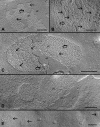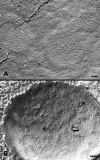Gap junction remodeling associated with cholesterol redistribution during fiber cell maturation in the adult chicken lens
- PMID: 19657477
- PMCID: PMC2720993
Gap junction remodeling associated with cholesterol redistribution during fiber cell maturation in the adult chicken lens
Abstract
Purpose: To investigate the structural remodeling in gap junctions associated with cholesterol redistribution during fiber cell maturation in the adult chicken lens. We also evaluated the hypothesis that the cleavage of the COOH-terminus of chick Cx50 (formerly Cx45.6) during fiber cell maturation would affect the gap junction remodeling.
Methods: Freeze-fracture TEM and filipin cytochemistry were applied to visualize structural remodeling of gap junction connexons associated with cholesterol redistribution during fiber cell maturation in adult leghorn chickens (42-62 weeks old). Freeze-fracture immunogold labeling (FRIL) was used to label the specific Cx50 COOH-terminus antibody in various structural configurations of gap junctions.
Results: Cortical fiber cells of the adult lenses contained three subtypes of cholesterol-containing gap junctions (i.e., cholesterol-rich, cholesterol-intermediate, and cholesterol-poor or -free) in both outer and inner cortical zones. Quantitative studies showed that approximately 81% of gap junctions in the outer cortex were cholesterol-rich gap junctions whereas approximately 78% of gap junctions in the inner cortex were cholesterol-free ones. Interestingly, all cholesterol-rich gap junctions in the outer cortex displayed loosely-packed connexons whereas cholesterol-free gap junctions in the deep zone exhibited tightly, hexagonal crystalline-arranged connexons. Also, while the percentage of membrane area specialized as gap junctions in the outer cortex was measured approximately 5 times higher than that of the inner cortex, the connexon density of the crystalline-packed gap junctions in the inner cortex was about 2 times higher than that of the loosely-packed ones in the outer cortex. Furthermore, FRIL demonstrated that while the Cx50 COOH-terminus antibody was labeled in all loosely-packed gap junctions examined in the outer cortex, little to no immunogold labeling was seen in the crystalline-packed connexons in the inner cortex.
Conclusions: Gap junctions undergo significant structural remodeling during fiber cell maturation in the adult chicken lens. The cholesterol-rich gap junctions with loosely-packed connexons in the young outer cortical fibers are transformed into cholesterol-free ones with crystalline-packed connexons in the mature inner fibers. In addition, the loss of the COOH-terminus of Cx50 seems to contribute equally to the transformation of the loosely-packed connexons to the crystalline-packed connexons during fiber cell maturation. This transformation causes a significant increase in the connexon density in crystalline gap junctions. As a result, it compensates considerably for the large decrease in the percentage of membrane area specialized as gap junctions in the mature inner fibers in the adult chicken lens.
Figures











References
-
- Cenedella RJ. Sterol synthesis by the ocular lens of the rat during postnatal development. J Lipid Res. 1982;23:619–26. - PubMed
-
- Zelenka PS. Lens lipids. Curr Eye Res. 1984;3:1337–59. - PubMed
-
- Li LK, So L, Spector A. Membrane cholesterol and phospholipid in consecutive concentric sections of human lenses. J Lipid Res. 1985;26:600–9. - PubMed
-
- Li LK, So L, Spector A. Age-dependent changes in the distribution and concentration of human lens cholesterol and phospholipids. Biochim Biophys Acta. 1987;917:112–20. - PubMed
-
- Li LK, So L. Age dependent lipid and protein changes in individual bovine lenses. Curr Eye Res. 1987;6:599–605. - PubMed
Publication types
MeSH terms
Substances
Grants and funding
LinkOut - more resources
Full Text Sources
Medical
Research Materials
Miscellaneous
